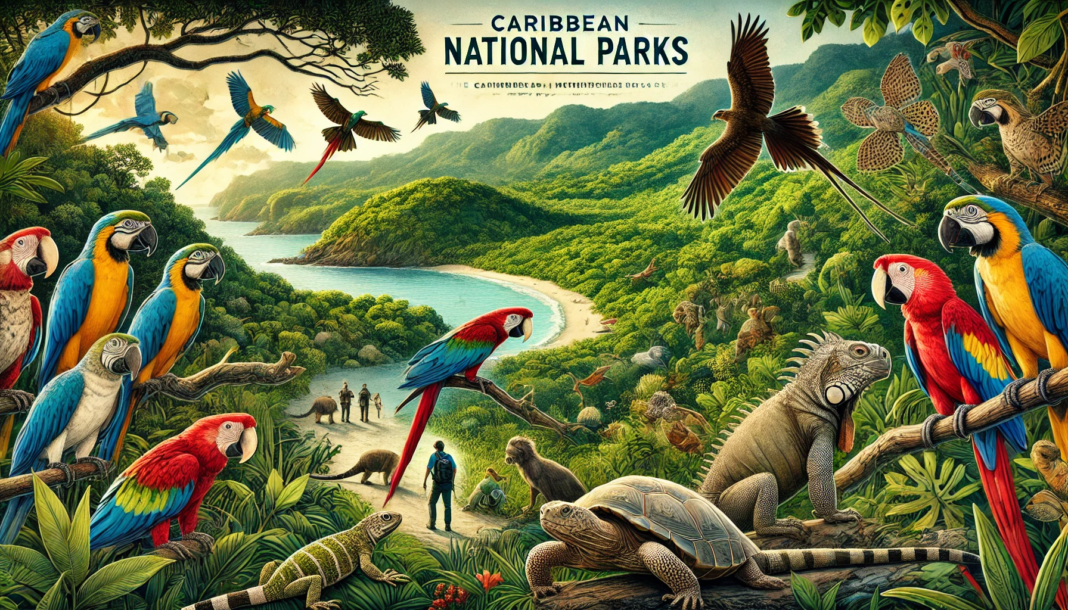The Caribbean is home to a remarkable variety of ecosystems, ranging from rainforests and mangroves to coral reefs and wetlands. These diverse habitats support an extraordinary array of wildlife, making the region a paradise for nature enthusiasts and wildlife watchers.
From the vibrant flamingos of the Bahamas to the elusive solenodons of the Dominican Republic, Caribbean national parks and nature reserves provide some of the best opportunities to see these animals in their natural environments.
In this guide, we’ll explore the top national parks and nature reserves where you can experience the rich wildlife of the Caribbean.
1. Zapata Swamp (Ciénaga de Zapata) – Cuba
Wildlife Highlights:
- Caribbean flamingos
- Cuban crocodiles
- Cuban Amazon parrots
- Manatees
Zapata Swamp, located in Cuba’s Matanzas Province, is the largest wetland in the Caribbean and a haven for wildlife enthusiasts. This UNESCO Biosphere Reserve is home to a wide variety of species, including the striking Caribbean flamingo, the rare Cuban crocodile, and numerous migratory birds. Birdwatchers flock here to see the more than 170 bird species, including the endemic Cuban Amazon parrot and bee hummingbird, the world’s smallest bird.
The swamp’s ecosystems, which include mangroves, lagoons, and swamps, support rich biodiversity, and the area is also a refuge for endangered species like the manatee. Guided boat tours offer a chance to see wildlife up close, while hiking trails lead you through its tropical wilderness.
Best Time to Visit:
- November to April (dry season and peak birdwatching season)
2. El Yunque National Forest – Puerto Rico
Wildlife Highlights:
- Puerto Rican parrots
- Coquí frogs
- Puerto Rican boa
- Tropical birds
Located in the northeastern part of Puerto Rico, El Yunque National Forest is the only tropical rainforest in the U.S. National Forest System. This lush, mountainous region is known for its towering waterfalls, dense foliage, and diverse wildlife. The forest is home to the endangered Puerto Rican parrot, one of the rarest birds in the world, and the melodious coquí frogs, whose distinctive calls fill the night air.
Hiking trails offer plenty of opportunities to explore the rainforest’s flora and fauna, including sightings of exotic birds and lizards. For a true wildlife experience, venture along the El Toro Trail or the Big Tree Trail for views of cascading waterfalls and encounters with the island’s unique wildlife.
Best Time to Visit:
- Year-round, but November to April is ideal for hiking.
3. Bonaire National Marine Park – Bonaire
Wildlife Highlights:
- Sea turtles
- Caribbean reef sharks
- Parrotfish
- Dolphins
The Bonaire National Marine Park is a protected underwater wonderland and one of the most well-preserved coral reef systems in the Caribbean. Surrounding the island of Bonaire, this marine park offers unparalleled opportunities for divers and snorkelers to encounter vibrant marine life. The park is home to species such as green sea turtles, Hawksbill turtles, Caribbean reef sharks, and countless tropical fish like parrotfish and angelfish.
The clear, warm waters provide an ideal environment for underwater exploration, where you can swim among colorful coral reefs, sea fans, and sponges. Klein Bonaire, a small islet near the main island, is particularly famous for its rich biodiversity and frequent dolphin sightings.
Best Time to Visit:
- Year-round, but the dry season (January to May) offers optimal visibility for diving.
4. Los Haitises National Park – Dominican Republic
Wildlife Highlights:
- Antillean manatees
- Solenodons
- Hispaniolan hutias
- Pelicans and frigatebirds
Los Haitises National Park, located on the northeast coast of the Dominican Republic, is a stunning natural reserve characterized by its limestone karst landscapes, mangrove forests, and ancient caves. The park is an important refuge for many species, including the elusive solenodon, a rare venomous mammal found only on the island of Hispaniola. Hispaniolan hutias, a large rodent species, also thrive here, along with the endangered Antillean manatee, which inhabits the park’s coastal waters and mangroves.
Los Haitises is particularly known for its birdwatching opportunities, with sightings of pelicans, frigatebirds, and herons. Boat tours take visitors through the mangrove-lined waterways, where you can explore caves adorned with ancient Taíno petroglyphs while spotting wildlife.
Best Time to Visit:
- November to April, during the dry season.
5. Caroni Swamp – Trinidad and Tobago
Wildlife Highlights:
- Scarlet ibis
- Egrets and herons
- Caimans
- Tropical birds
Caroni Swamp, located just outside the capital city of Port of Spain in Trinidad, is a mangrove wetland that serves as a sanctuary for many bird species, most notably the scarlet ibis, the national bird of Trinidad and Tobago. At sunset, large flocks of scarlet ibises return to the swamp to roost, creating a breathtaking display of red against the evening sky.
The swamp is also home to a variety of wildlife, including caimans, tree boas, and numerous fish species. Guided boat tours through the waterways offer visitors the chance to observe wildlife while learning about the importance of the swamp’s ecosystem.
Best Time to Visit:
- Year-round, but the best time to see scarlet ibises is at sunset.
6. Graeme Hall Nature Sanctuary – Barbados
Wildlife Highlights:
- Egrets and herons
- Migratory birds
- Mangrove wildlife
Located on the southern coast of Barbados, the Graeme Hall Nature Sanctuary is one of the last remaining mangrove forests on the island. This 240-acre wetland is home to an array of bird species, making it a prime spot for birdwatching. Egrets, herons, and migratory birds can often be seen wading through the swampy waters, while fish and crabs inhabit the mangroves.
The sanctuary also plays a critical role in conservation, serving as an educational center for preserving the island’s delicate ecosystems. Visitors can enjoy peaceful walks along the boardwalks and trails, while observing the rich biodiversity of this coastal wetland.
Best Time to Visit:
- November to April (for migratory bird sightings).
7. The Exuma Cays Land and Sea Park – Bahamas
Wildlife Highlights:
- Rock iguanas
- Nurse sharks
- Sea turtles
- Tropical fish
The Exuma Cays Land and Sea Park, located in the Bahamas, is a marine protected area known for its pristine waters, vibrant coral reefs, and abundant marine life. Visitors to the park can expect to encounter a variety of wildlife, including rock iguanas, nurse sharks, and various sea turtles. The park is also a sanctuary for bird species and tropical fish, making it a perfect destination for snorkeling and diving enthusiasts.
One of the unique features of this park is its emphasis on conservation, where no fishing or harvesting is allowed, ensuring that the natural ecosystems remain undisturbed. The park’s crystal-clear waters offer some of the best visibility in the region, ideal for spotting marine creatures.
Best Time to Visit:
- Year-round, with calm seas in winter and spring for snorkeling and diving.
8. Dominica’s Morne Trois Pitons National Park
Wildlife Highlights:
- Lesser Antillean iguanas
- Sisserou parrots (Imperial Amazon)
- Mountain chicken frogs
- Bats and tropical birds
Morne Trois Pitons National Park, a UNESCO World Heritage Site, is located in the rugged volcanic terrain of Dominica. This park is home to the island’s highest peaks, dense rainforests, and an abundance of wildlife. One of the park’s most iconic species is the Sisserou parrot, also known as the Imperial Amazon, which is endemic to Dominica and the island’s national bird.
The park is also home to the critically endangered mountain chicken frog, which is one of the largest frogs in the world. The park’s unique volcanic features, such as the Boiling Lake and Trafalgar Falls, add to the experience of exploring the island’s wild interior.
Best Time to Visit:
- December to May (dry season), ideal for hiking and wildlife viewing.
9. The Garrison Savannah – Barbados
Wildlife Highlights:
- Mongoose
- Egrets and herons
- Tropical birds
Although best known for its rich military history, the Garrison Savannah in Barbados is also home to various species of birds and the occasional sighting of the Indian mongoose, which was introduced to the island in the 19th century. The Savannah is located near the coast, offering views of the nearby beaches and providing habitat for wading birds like egrets and herons.
Visitors can explore the grounds while learning about the island’s colonial past or take a relaxing walk through this historically significant area.
Best Time to Visit:
- Year-round, with historical tours available.
10. Arikok National Park – Aruba
Wildlife Highlights:
- Aruban whiptail lizards
- Aruban burrowing owls
- Bats and iguanas
Arikok National Park, which covers nearly 20% of Aruba, is a vast expanse of rocky landscapes, desert dunes, caves, and stunning coastline. This park is home to the island’s endemic species, including the Aruban whiptail lizard and the Aruban burrowing owl, both of which are protected within the park. Arikok’s unique flora and fauna are adapted to the island’s arid conditions, and visitors will also encounter iguanas, bats, and tropical birds.
Hiking trails lead through the park’s diverse terrain, offering dramatic views of the island and its wildlife, as well as cultural landmarks like ancient Arawak petroglyphs.
Best Time to Visit:
- November to April for cooler hiking conditions.
Conclusion
The Caribbean is a treasure trove of natural beauty and biodiversity, with its national parks and nature reserves offering some of the best wildlife experiences in the region. Whether you’re exploring lush rainforests, mangrove swamps, or coral reefs, these protected areas provide a chance to witness some of the most fascinating animals in their natural habitats. From the striking scarlet ibis of Trinidad to the elusive solenodons of the Dominican Republic, the Caribbean’s national parks are a must-visit for any wildlife enthusiast.
FAQ
What is the best time to visit Caribbean national parks for wildlife viewing?
The best time to visit most Caribbean national parks is during the dry season, typically from November to April, when the weather is cooler, and wildlife is more active.
Are there any endangered species in Caribbean national parks?
Yes, many Caribbean national parks are home to endangered species, including the Puerto Rican parrot in El Yunque, the Blue Iguana in Grand Cayman, and the Solenodon in Los Haitises National Park.
What is the best national park in the Caribbean for birdwatching?
Caroni Swamp in Trinidad is one of the best locations for birdwatching, particularly for seeing the scarlet ibis. Other great birdwatching spots include Zapata Swamp in Cuba and Graeme Hall Nature Sanctuary in Barbados.
Can you dive in any of the Caribbean’s national parks?
Yes, some of the best diving spots in the Caribbean are in national parks, including the Bonaire National Marine Park and the Exuma Cays Land and Sea Park in the Bahamas, where you can encounter a variety of marine wildlife.
What is the most unique wildlife in the Caribbean?
The Caribbean is home to several unique and endemic species, including the rare solenodon in the Dominican Republic, the Aruban whiptail lizard, and the mountain chicken frog in Dominica.

